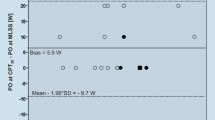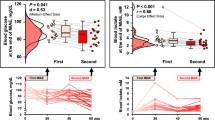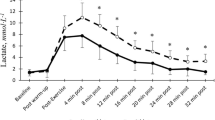Abstract
Eight highly trained male kayakers were studied to determine the relationship between critical power (CP) and the onset of blood lactate accumulation (OBLA). Four exercise sessions of 90 s, 240 s, 600 s, and 1200 s were used to identify the CP of each kayaker. Each individual CP was obtained from the line of best fit (LBFCP) obtained from the progressive work output/time relationships. The OBLA was identified by the 4 mmol·l−1 blood lactate concentration and the work output at this level was determined using a lactate curve test. This consisted of paddling at 50 W for 5 min after which a 1-min rest was taken during which a 25-μl blood sample was taken to analyse for lactate. Exercise was increased by 50 W every 5 min until exhaustion, with the blood sample being taken in the 1-min rest period. The exercise intensity at the OBLA for each subject was then calculated and this was compared to the exercise intensity at the LBFCP. The intensity at LBFCP was found to be significantly higher (t=2.115, P<0.05) than that at the OBLA of 4 mmol·1−1. These results were further confirmed by significant differences being obtained in blood lactate concentration (t=8.063, P<0.05) and heart rate values (t=2.90, P<0.05) obtained from the exercise intensity at LBFCP over a 20-min period and that of the anaerobic threshold (Than) parameters obtained from the lactate/heart rate curve. These differences suggest that CP and Than are different physiological events and that athletes have utilised either one or the other methods for monitoring training and its effects.
Similar content being viewed by others
References
Bulbian R, Wilcox AR, Darabos BL (1986) Anaerobic contribution to distance running performance of trained cross-country athletes. Med Sci Sports Exerc 18:107–113
De Vries HA, Moritani T, Nagata A, Magnussen K (1982) The relation between critical power and neuromuscular fatigue as estimated from EMG data. Ergonomics 25:783–791
De Vries HA, Tichy MW, Housh TJ, Smyth KD, Tichy A, Housh DJ (1987) A method for estimating physical working capacity at the fatigue threshold. Ergonomics 30:1195–1204
Dotan R, Rotstein A, Grodjinovsky A (1989) The effect of training on OBLA determination. Int J Sports Med 10:345–351
Hagberg JM (1984) Physiological implications of the lactate threshold. Int J Sports Med 5:106–109
Heck H, Mader A, Hess G, Mucke S, Muller R, Hollman W (1985) Justification of the 4 mmol/L lactate treshold. Int J Sports Med 6:117–130
Hollmann W (1985) Historical remarks on the development of the aerobic-anaerobic threshold up to 1966. Int J Sports Med 6:109–116
Housh DJ, Housh TJ, Bauge SM (1989) The accuracy of critical power test for predicting time to exhaustion during cycle ergometry. Ergonomics 32:997–1004
Housh TJ, Johnson GO, McDowell SL, Housh DJ, Pepper M (1991) Physiological responses at the fatigue threshold. Int J Sports Med 12:305–308
Jenkins DG, Quigley BM (1990) Blood lactate in trained cyclists during cycle ergometry at critical power. Eur J Appl Physiol 61:278–283
Jenkins DG, Quigley BM (1991) Critical power in the assessment of athletic ability. Sports Coach 14:18–22
Jones NL, Ersham RE (1982) The anaerobic threshold. Exerc Sports Sci Rev 10:49–83
Kindermann W, Simon G, Keul J (1979) The significance of the aerobic-anaerobic transition for the determination of work load intensities during endurance training. Eur J Appl Physiol 42:25–34
McLellan TM, Cheung KSY (1992) A comparative evaluation of the individual anaerobic threshold and critical power. Med Sci Sports Exerc 24:543–550
McLellan TM, Jacobs I (1989) Active recovery, endurance training and the calculation of the individual anaerobic threshold. Med Sci Sports Exerc 21:586–592
McLellan TM, Cheung KSY, Jacobs I (1991) Incremental test protocol, recovery mode, and the individual anaerobic threshold. Int J Sports Med 12:190–195
Monod H, Scherrer J (1965) The work capacity of a synergic muscle group. Ergonomics 8:329–338
Moritani T, Nagata A, De Vries HA, Muro M (1981) Critical power as a measure of physical work capacity and anaerobic threshold. Ergonomics 24:339–350
Nagata A, Moritani T, Muro M (1983) Critical power as a measure of muscular fatigue threshold and anaerobic threshold. In: Matsui H, Kafayassi K (eds) Biomechanics IV A. Human Kinetics, Champagn, Ill., pp 312–320
Nebelsick-Gullet LJ, Housh TJ, Johnson GO, Bauge SM (1988) A comparison between methods of measuring anaerobic work capacity. Ergonomics 31:1413–1429
Overend TJ, Cunningham DA, Paterson DH, Smith WDF (1992) Physiological responses of young and elderly men to prolonged exercise at critical power. Eur J Appl Physiol 64:187–193
Sjodin B, Jacobs I (1981) Onset of blood lactate accumulation and marathon running performances. Int J Sports Med 2:23–26
Sjodin B, Jacobs I, Karlsson J (1981) Onset of blood lactate accumulation and enzyme activities in m. vastus lateralis in man. Int J Sports Med 2:166–170
Stegmann H, Kindermann W (1982) Comparison of prolonged exercise tests at the individual anaerobic threshold and the fixed anaerobic threshold of 4 mmol/L Lactate. Int J Sports Med 3:105–110
Stegmann H, Kindermann W, Schabel A (1981) Lactate kinetics and individual anaerobic threshold. Int J Sports Med 2:160–165
Wasserman K, Van Kessel AL, Burton GG (1967) Interaction of physiological mechanisms during exercise. J Appl Physiol 22:71–85
Wasserman K (1984) The anaerobic threshold measurement to evaluate exercise performance. Am Rev Respir Dis 129:535–540
Author information
Authors and Affiliations
Rights and permissions
About this article
Cite this article
Clingeleffer, A., Mc Naughton, L.R. & Davoren, B. The use of critical power as a determinant for establishing the onset of blood lactate accumulation. Europ. J. Appl. Physiol. 68, 182–187 (1994). https://doi.org/10.1007/BF00244033
Accepted:
Issue Date:
DOI: https://doi.org/10.1007/BF00244033




